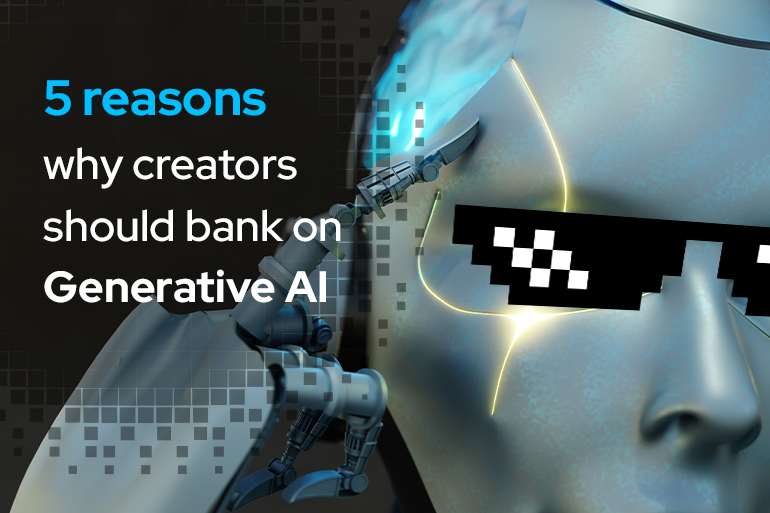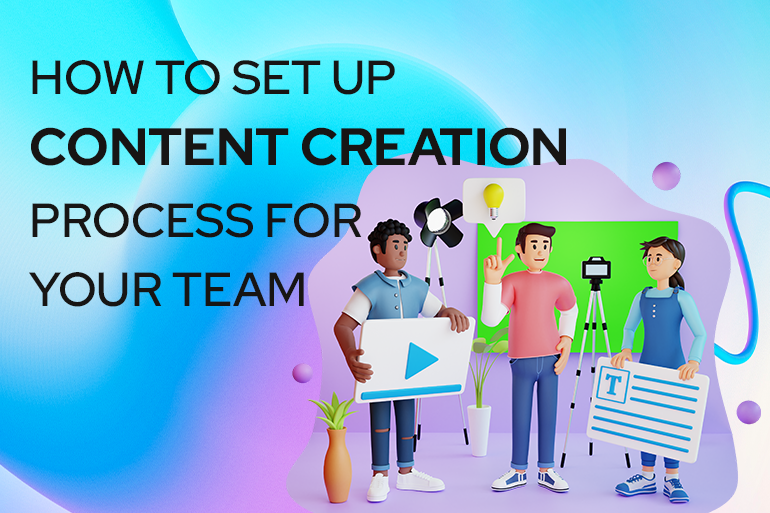In today’s content-driven era, it is imperative to create high-quality content to capture an audience’s attention. Content creation can be time-consuming, and sometimes we hit a creative block that makes it challenging to develop new ideas. This is where generative AI comes in.
Recently, ChatGPT has taken the content marketing world by storm with its impressive capabilities. While it can be intimidating, generative AI can also be a boon for creators. This blog will share five reasons content creators should bank on generative AI for creating their content. But before that, let’s understand what exactly is generative AI.
What is generative AI?
Generative AI is a type of artificial intelligence that uses algorithms to generate new and unique content from existing data. This technology is different from traditional AI, which typically involves classifying and processing existing data to make recommendations or decisions. Generative AI has the ability to create something entirely new from scratch, such as a piece of music, an image, a video, or even a piece of written content.
For creators, generative AI can be a powerful tool for enhancing their work and streamlining their creative process. One major benefit of generative AI is its ability to automate time-consuming tasks such as content creation and editing. By using algorithms to generate content, creators can save time and focus on other important aspects of their work. Generative AI can also help creators explore new and innovative ideas that they may not have thought of otherwise. By analyzing existing data, generative AI can identify patterns and generate new content that is unique and engaging.
Overall, generative AI has the potential to revolutionize the way creators approach their work, allowing them to create more efficiently and effectively while exploring new and innovative ideas.
Why should creators bank on generative AI?
In recent times, there has been a debate about whether or not generative AI is reliable. But, as technology evolves, generative AI has also evolved. This section will give you about five solid reasons why you should bank on generative AI for content creation.
#1 Gives you flash speed.
Who doesn’t want to finish their work as fast as they can? Producing content from scratch can take time, especially if you’re working on many projects at the same time. From idea generation to editing, the process might take hours, if not days. Using generative AI to create content can save a substantial amount of time. Creators can use AI-powered tools to automate chores like writing emails, creating subtitles, and even suggesting new content ideas based on previous performance.
This saves time and allows artists to concentrate on more creative aspects of their work. Generative AI solutions can assist in speeding up the content creation process by performing tasks in a fraction of the time. This frees up content creators’ time for other elements of content development, such as editing and post-production.
#2 Generates unique content intelligently
One of the biggest challenges for content creators is coming up with unique ideas that stand out from the crowd. Generative AI can help generate content based on specific criteria such as keywords, themes, and tone. This means that creators can generate unique content that resonates with their audience while saving time and effort.
AI-powered tools can analyze audience behavior and preferences data, allowing creators to personalize their content for their audience. By tailoring content to the needs and interests of their audience, creators can increase engagement and build a loyal following.
#3 Gets the creative juices flowing.
Generative AI has the potential to be a game changer for content creators, providing them with strong tools to boost their creativity and generate novel ideas. One of the most significant benefits of incorporating AI into content creation is its capacity to examine trends and patterns in content performance, providing producers with important insights and ideas to inspire their work. Furthermore, generative AI can assist creators in breaking past creative blocks and pushing the boundaries of their work. AI can inspire creators to come up with fresh and intriguing new ideas that would not have occurred to them otherwise by analyzing patterns in existing content and discovering new and developing trends.
Ultimately, generative AI has the ability to change the way creators approach their work by giving them strong new tools to boost their creativity and push the frontiers of their craft. Creators can unlock new chances for growth and success in the ever-changing digital landscape by embracing this technology.
#4 Saves your cash.
It is critical to create high-quality content in order to engage audiences and build a successful brand. Hiring a team of pros to create such content, on the other hand, might be an expensive operation. This is where generative AI enters the picture. Saving money is one of the major advantages of employing generative AI in content development. AI-powered solutions can automate operations like video editing, sound design, and graphic design, dramatically lowering production costs. AI-powered voiceover tools, for example, can transcribe and narrate videos, saving artists both time and money.
Furthermore, generative AI can help creators produce high-quality content at a fraction of the cost. By automating tasks that would typically require a team of professionals, creators can allocate their resources more efficiently and produce content that is just as good, if not better, than what a team of professionals would create.
#5 Caters to personalization.
As audiences want personalized experiences that fit their particular requirements and interests, personalization is becoming increasingly crucial in content creation. By evaluating data about individual users, generative AI can assist content creators in creating content that is tailored to their interests.
Personalization of content allows authors to provide a more engaging and meaningful experience for their audiences. Tailoring information to each user’s specific interests and preferences can enhance the likelihood of their connecting with it, resulting in increased engagement rates, longer watching durations, and, eventually, a more loyal following.
Generative AI can also help content creators identify emerging trends and patterns in user behavior, enabling them to adjust their content strategy and produce content that is more likely to resonate with their audiences. Moreover, personalization can help content creators achieve greater marketing effectiveness by delivering targeted messages to specific audiences.
Ace your creations with these day-to-day AI tools.
Here’s a list of AI tools to make your content creation easier.
Dall – E– DALL-E is an AI-powered image generation system developed by OpenAI. It uses a deep neural network to create original images from textual descriptions. The system is capable of generating highly realistic and detailed images of objects, animals, and scenes that do not exist in the real world, based solely on written prompts.
ChatGPT – As a powerful language model, ChatGPT can be a valuable tool for creators looking to streamline their workflow and generate new ideas. Creators can use ChatGPT to generate new content ideas, refine their writing skills, or even as writing assistants for content creation. ChatGPT’s ability to understand natural language and provide coherent responses can benefit brainstorming and idea generation, as it can provide diverse perspectives and insights.
illusto – illusto is an AI tool that simplifies the video editing process for creators. It is an easy-to-use online video editor with powerful features powered by artificial intelligence. Its easy-to-use platform integrates with various AI tools and services to streamline the video editing process and enhance the quality of the final product.
Hootsuite Insights – Hootsuite Insights is a social listening tool that uses AI to analyze social media conversations and provide insights into audience sentiment, interests, and behaviors. Creators can use Hootsuite Insights to inform their content strategy and tailor it to their audience’s needs.
Lumen5 – Lumen5 is a video creation platform that uses AI to automate video editing. Creators can use Lumen5 to turn blog posts, articles, and other text-based content into engaging videos.
Grammarly – Grammarly is a writing assistant that uses AI to suggest grammar, spelling, and style. Creators can use Grammarly to ensure that their writing is clear, concise, and error-free.
Wordsmith – Wordsmith is a natural language generation tool using AI to generate written content automatically. Creators can use Wordsmith to create product descriptions, news articles, and other written content quickly and efficiently.
Boords: Boords is an AI-powered storyboarding tool that can help creators plan out their video content. It can automatically generate storyboards based on the script and audio input and suggest shot compositions and transitions.
Generative AI is here to stay.
After exploring the potential benefits of generative AI for creators, it’s clear that this technology has the potential to revolutionize the way we create and consume content. By embracing this technology, creators can increase efficiency, creativity, personalization, scalability, and cost-effectiveness, leading to a more successful and satisfying career.
Creators can bank on these generative AI tools to generate content and endless ideas on various topics. However, when it comes to bringing these ideas to life, content creators can bank on illusto. It is one such tool that aims at making video editing easy for everyone. So, what are you waiting for? Start leveraging the power of generative AI combined with illusto and skyrocket your career as a creator.
Sign up on illusto.com today.







